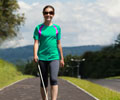After more than two decades of civil war, the war-ravaged region of Southern Sudan is grossly impoverished . Life, for its 8 million population, is tough in a country struggling to rebuild itself. And it’s even tougher for those who have been permanently afflicted with blindness due to preventable diseases, some of which have been largely eradicated in other parts of Africa.
"I want to find a job. That is hard for everyone and I cannot see well," said 14-year-old Nelson Deng. He says he lost most of his sight after an infection as a young child.Nelson has not been to school since returning to the southern capital Juba when peace was signed in 2005. Today he sells cigarettes to supplement his family's miserable income.
"I even find it hard to tell what money people are giving me, so I don't know what I can do," he adds.
Yet he is far from alone. Blindness, which is often easily preventable, is a common problem in a region hit hard by lack of infrastructure and health services, and gripped by a dangerous combination of fly-carried eye diseases.
"The problems are very heavy," said Ali Yousif Ngor, acting head of eye care services at the health ministry for the semi-autonomous south.
"We suffer with not one, but two blinding diseases -- river blindness (onchocerciasis) and trachoma."
Advertisement
It's rare that river blindness, spread by flies near fast flowing water, and trachoma, from flies feeding on faeces, still exist in the same country.
Advertisement
"But the years of war have meant that it's not been possible to do that in south Sudan."
The health ministry hopes to halve blindness rates by 2020 through a massive overhaul of the health system, but it's a gigantic task.
Precise population statistics don't exist for the south but the ministry suggests 1.5 percent of an estimated eight million people are blind.
Regional surveys, however, suggest rates four percent higher or even more in some places -- four times the rate pegged by the World Health Organization as a public health problem.
"We need and are working for long-term solutions," Ngor said.
Draft plans have been drawn up, with funding planned to come equally from the southern government and international donors.
In the meantime, preventative drugs to combat the river blindness flies, whose bite injects parasites into the body which inflame the eyes, reach just over a quarter of those at risk.
The fly has reportedly driven out whole villages in endemic zones of Western Equatoria, and Northern and Western Bar al-Ghazal, where spot assessments have found infection rates of more than 80 percent, and blindness rates of 12 percent.
Efforts too are being made to tackle trachoma -- a fly-spread infection encouraged by poor sanitation -- through encouraging regular eye-washing to remove the dirt that acts as a magnet for flies.
A simple course of antibiotics can stop it, but repeated infections cause eyelashes to grow inward, leading to permanent scarring of the eyeball.
Along the north-south border in Mankien district, 47 percent of children aged under nine were found to have active trachoma, which, if left untreated, will lead to blindness.
Over 200,000 wait for surgery to pull the eye-lid back -- in those hot-spot areas across the south where surveys have been conducted an average of 10 percent of the population are in need.
Cataracts, where the eye lens grows cloudy with age, are another major cause of preventable blindness.
It's a relatively simple operation to remove them, but south Sudan has only two medics able to conduct operations, and must rely on support from visiting doctors to tackle an estimated backlog of 60,000 cases.
"We just don't have the surgeons or the clinical officers," Ngor said.
"The problem in south Sudan is not only disease itself -- it's the problem of how to build the capacity of the local people, to help them cater for their own people."
Meanwhile, those already struggling without sight, try to improve their lives on their own.
"There are many problems. People are poor and jobless," said Edema Eriko Anthony, secretary general of the Association for Visually Impaired, a simple brick building with a rusting tin roof in Juba.
The center provides practical training, including handicraft skills such as basket weaving in the hope of providing its members with a small income.
"We work hard, but we survive on our own without funding," adds Anthony, himself partially sighted, holding up a white cane of the type used by the blind worldwide.
"These are too expensive -- each is about three dollars -- and we cannot even get the papers we need for writing Braille for our educational programme."
High rates of blindness put pressure on families already struggling to rebuild their communities, with children staying home to care for older relatives who can no longer see.
"The war reduced our work to nothing," said Ben Lou Poggo, a teacher at south Sudan's only school for the blind, with around 30 primary school pupils.
"But now there is peace, we believe there will be changes, such that the blind children will be able to go to school and learn."
Source-AFP
TAN/L












